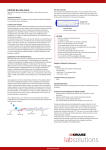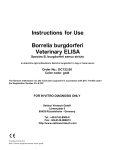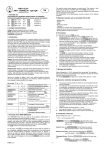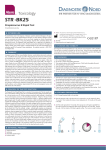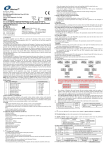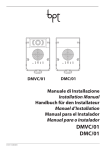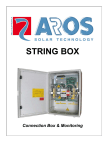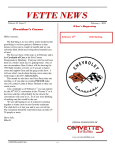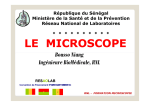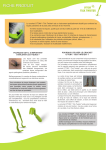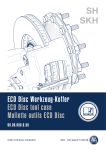Download User Manual - Diagnostik Nord
Transcript
BOR-K20 Tick rapid test for Borrelia The rapid test for direct borrelia detection in ticks INTENDED USE The Diagnostik Nord Borrelia antigen test (BOR-K20) directly detects Borrelia (B. garinii, B. afzellii and B. burgdorferi sensu stricto) the Pathogens of Lyme borreliosis in the tick. The Lyme disease is a serious illness that is transmitted by ticks. The causative agent of Lyme disease, Borrelia burgdorferi sensu lato, is a gram-negative, spiral-shaped and mobile bacterium (spirochete). Globally, at least 13 Genospecies belong to the Borrelia burgdorferi sensu lato complex. The 3 main species B. burgdorferi sensu stricto (BSS), B. garinii (Bg) and B. afzellii (Ba) are also human pathogens. Borrelia are transmitted by ticks of the genus Ixodes ricinus (Ixodes Ricinus). In Europe, the prevalence of Borrelia in ticks is regionally different (5-35%). If a tick has already engorged itself with blood, it cannot be excluded as the potential infecting agent, and the tick should be examined for borrelia. A negative tick does not excclude an infection with borrelia. A Borrelia infection in humans can only be diagnosed by a physician, the test is only used for the detection of Borrelia in the ticks. PLEASE NOTE BEFORE USE: • Use a new test cassette for every individual test and tick tube. • Only for one-time usage. • Use only the original test components provided in the kit. Only for one-time usage. • Use the test cassette within 60 minutes after opening the pouch. • The test cassette must be in a horizontal position on a smooth surface under while the test is performed. • Note, the amount of reagen depends on the size of the tick needed. An incorrect number of drops or too small drops may lead to false test results. • Consider the test results as invalid after the specified read out time. • Do not use the test after the expiration date printed on the pouch only for one-time usage. FOR USE IN TICKS • The tick must be crushed thoroughly - the borrelia is located in the tick‘s colon. • Try to keep the sample field clear of any tick particles. • Only use the wooden stick for the purpose described here. • Immediately take the wooden stick out of the reagent mixture after crushing the tick. TEST PROCEDURE Carefully remove the tick and make sure that the head is removed as well. Tick pliers are recommended. After the tick has been removed and before beginning the test, you can store the tick in the supplied sample tube. Testing the tick directly after removal yields the best results. A second point is the crushing procedure for an optimal testing. The borrelia to be verified is located in the tick‘s colon. Only a thorough crushing of the colon can yield an optimal result. An optimal test execution depends on the size of the tick. If a small to medium-sized tick is to be tested (< 8 mm) test procedure „Small to medium sized ticks“ should be followed. If the tick to be tested is a large, heavily engorged tick (the body of the tick shows a significant size increase; > 8 mm), only one drop of the tick juice is tested according to test procedure „Large ticks“ should be followed. Small to medium sized ticks (< 8 mm) 1. Place the tick in the sample tube and fill the sample tube with 3 drops of reagent liquid. 2. Crush the tick with the wooden stick until the liquid becomes discolored. Use the sharp and dull side of the wooden stick for this purpose. Then remove the wooden stick. 3. Take up the tick-reagent mixture with the pipette. Ensure that you do not take up any tick particles. 4. Place the tick-reagent mixture on the sample field of the test set. Ensure that you do not take up any tick particles with the pipette as these could clog up the sample field. 5. The liquid starts to run across the test strip. Note: it makes little sense to test very small ticks that have not yet been drawn, or to test nymphs, since the destruction of the intestine is difficult. Application tips if the liquid does not run properly: If large particles have gotten onto the sample field, you can also press down on the sample field with the tip of the pipette, causing the liquid to run again or add another drop of reagent liquid onto the sample field. STORAGE OF THE TESTKITS The Diagnostik Nord test kit should be stored between 2-30 °C. COMPONENTS OF THE TEST KIT The results of the test can be read after 10 minutes. The maximum read out time is 20. Large ticks 1. Place the engorged tick in the tick tube. 2. Crush the tick with the supplied wooden stick (sharp side) so that the tick juice excretes and the colon is crushed. Then remove the wooden stick. 3. Take up the tick juice with the pipette. Ensure that you do not take up any tick particles. 4. Add a drop of tick juice on the sample field of the test set, and let it soak for a few seconds. 5. Add 2 drops of reagent liquid. The liquid starts to slowly run across the test strip. Application tips if the liquid does not run properly: If large particles have gotten onto the sample field, you can also press down on the sample field with the tip of the pipette, causing the liquid to run again or add another drop of reagent liquid onto the sample field. SYMBOLS n Content Lot number For single use only Expiry date Carefully read package insert Keep dry The results of the test can be read after 10 minutes. The maximum read out time is 20. POSITIVE Positive test result: Read for a positive result, two red lines appear in the reaction field of the test cassette. A red line in the T-region (T) of the reaction field indicates a positive test result. Borrelia antigen was detected in the tick. The less Borrelia antigens are present, the weaker the T-line. Also a faint test line is considered as a positive test result. The second red line in the C- region (C) indicates the control line, which indicates the correct performance of the test. The C-line is not a reference line and may have a different line intensity than the T-Line. NEGATIVE Negative test result: Only the control line appears. INVALID Invalid test result: If no control line appears after the test is conducted, the test is invalid. In this case, it is likely that the test was not properly conducted or that the expiration date had already lapsed. If this occurs, a new test must be conducted. For the case of a strong background staining after 10 minutes, the test cassette can be hold under cold running water for one minute to wash the background color away; the test result is visible. TEST PERFORMANCE Sensitivity comparison system (study 2009 and 2013/2014): Polymerase Chain Reaction (PCR) Sensitivity 92.86 % Store at room temperature 2-30°C catalogue number Rev.: 06.10.2015 (JM) replace 08.07.2015 PRODUCER TEST RESULT Diagnostik Nord Borrelia antigen test 30 °C 2 °C Specificity 95.83 % PPW/NPW 86.67 %/ 97.87 % TTP 95.35 % Specificity An analysis (Comparison study 2012/2013) of spiked ticks in the PCR compared with the Diagnostik Nord Borrelia antigen test revealed that Borrelia of the following species were detected in both test systems: B. burgdorferi sensu stricto, B. afzelii and B. spielmanii LITERATURE J. Eckert, K.T. Friedhoff, H. Zahner, P. Deplazes: „Lehrbuch Der Parasitologie für die Tiermedizin“, Enke Verlag, 2.vollst. überarb. Aufl. 2008 W. Luttmann, K. Bratke, M. Küpper, D. Myrtek: „Der Experimentator Immunologie“, Spektrum Akademischer Verlag, S.110 f., 3. Auflage 2009 Diagnostik Nord GmbH Mecklenburgstr. 97 19053 Schwerin Germany Telefon: Fax: E-Mail: Internet: +49 (0)385/208409-0 +49 (0)385/208409-29 [email protected] www.diagnostik-nord.de


